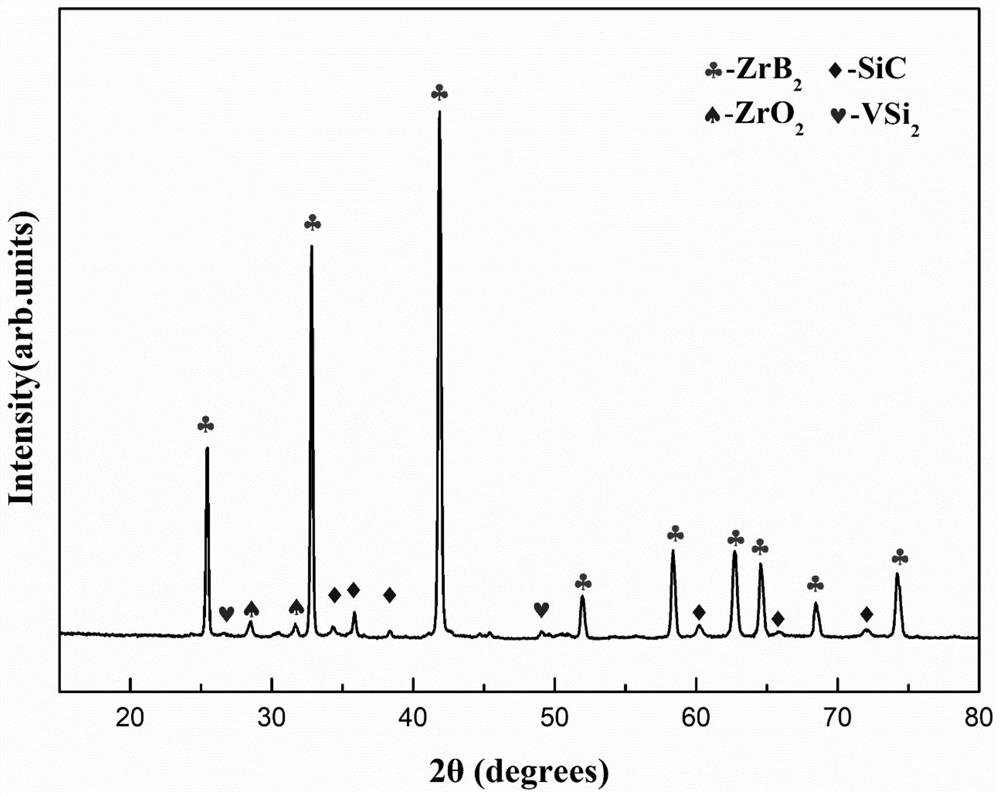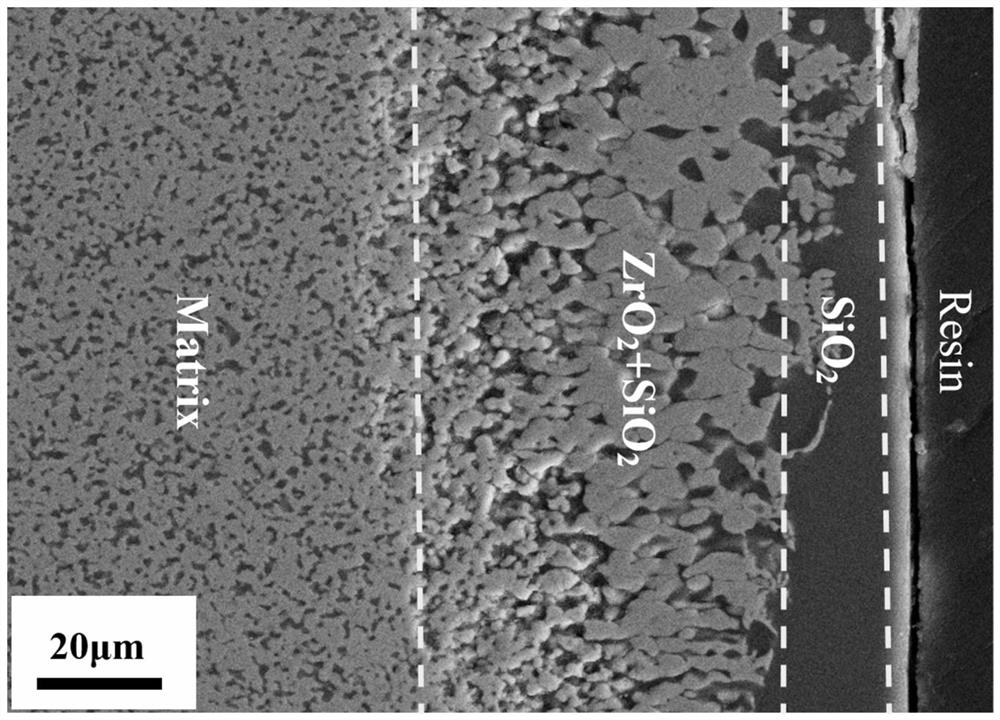a zrb 2 -sic-vsi 2 Ultra-high temperature ceramic composite material and its preparation method
A technology of ceramic composite materials and ultra-high temperature ceramics, which is applied in the direction of reducing greenhouse gases, nuclear power generation, climate sustainability, etc. The effect of short preparation time, inhibition of grain growth, and easy operation
- Summary
- Abstract
- Description
- Claims
- Application Information
AI Technical Summary
Problems solved by technology
Method used
Image
Examples
Embodiment 1
[0041] ZrB with a particle size of 0.5 μm 2 Powder 15.94g, SiC powder with particle size 0.5 2.41g and VSi with particle size 1μm 2 Powder 1.65g (the volume fraction ratio of the three ceramic powders is ZrB 2 : SiC: VSi 2 =70:20:10) Put it into a nylon ball mill jar and mill it for 12h. The mixed ceramic powder was obtained by rotating and drying in a rotary evaporator (evaporating pressure 5kPa) at 60°C at a speed of 70rpm, and then passing through an 80-mesh sieve to obtain a mixed ceramic powder, which was then put into a graphite mold with a diameter of 25mm and the inner wall was coated with BN and cold-pressed at 5kN. 5min. Then, the graphite mold containing the mixed ceramic powder was hot-pressed and sintered in protective Ar with a flow rate of 3 L / min, heated to 1600 °C at a heating rate of 8 °C / min, and the pressure was gradually increased to 30 MPa, and the temperature was kept for 0.5 h. After the insulation, the temperature was lowered to 1200°C at 10°C / min,...
Embodiment 2
[0043] ZrB with a particle size of 2 μm 2 Powder 15.76g, SiC powder with particle size of 2μm 1.79g and VSi with particle size of 3μm 2 Powder 2.45g (the volume fraction ratio of the three ceramic powders is ZrB 2 : SiC: VSi 2 =70:15:15) Put it into a nylon ball mill jar and mill it for 24h. At 55°C at 75 rpm, rotate and dry in a rotary evaporator (evaporation pressure 3 kPa) and pass through a 100-mesh sieve to obtain a mixed ceramic powder, which is then put into a graphite mold with a diameter of 25 mm and the inner wall is coated with BN and cold-pressed at 5 kN. Formed for 8 minutes. Then, the graphite mold containing the mixed ceramic powder was hot-pressed and sintered in a vacuum (vacuum degree 10 -2 Pa), heated to 1550 °C at a heating rate of 8 °C / min, while the pressure was gradually increased to 30 MPa, and kept for 1 h. After the insulation, the temperature was lowered to 1000°C at 12°C / min, and air-cooled to room temperature to obtain ZrB 2 -SiC-VSi 2 Ultra...
Embodiment 3
[0045] ZrB with a particle size of 1 μm 2 Powder 15.03g, SiC powder with particle size of 1μm 2.45g and VSi with particle size of 2μm 2 Powder 2.52g (the volume fraction ratio of the three ceramic powders is ZrB 2 : SiC: VSi 2 =65:20:15) Put it into a nylon ball mill jar and mill it for 16h. The mixed ceramic powder was obtained by rotating and drying in a rotary evaporator (evaporating pressure 8kPa) at 50rpm at 70°C, and then passing through a 120-mesh sieve to obtain a mixed ceramic powder, which was then put into a graphite mold with a diameter of 25mm and coated with BN on the inner wall and cold pressed at 10kN. Formed for 5 minutes. Then, the graphite mold containing the mixed ceramic powder was heated at a flow rate of 5 L / min in a protective N 2 Medium hot pressing sintering, heating to 1650 °C at a heating rate of 15 °C / min, while the pressure was gradually increased to 35 MPa, and the temperature was kept for 0.5 h. After the insulation, the temperature was low...
PUM
| Property | Measurement | Unit |
|---|---|---|
| particle diameter | aaaaa | aaaaa |
| particle size | aaaaa | aaaaa |
Abstract
Description
Claims
Application Information
 Login to View More
Login to View More - R&D
- Intellectual Property
- Life Sciences
- Materials
- Tech Scout
- Unparalleled Data Quality
- Higher Quality Content
- 60% Fewer Hallucinations
Browse by: Latest US Patents, China's latest patents, Technical Efficacy Thesaurus, Application Domain, Technology Topic, Popular Technical Reports.
© 2025 PatSnap. All rights reserved.Legal|Privacy policy|Modern Slavery Act Transparency Statement|Sitemap|About US| Contact US: help@patsnap.com



